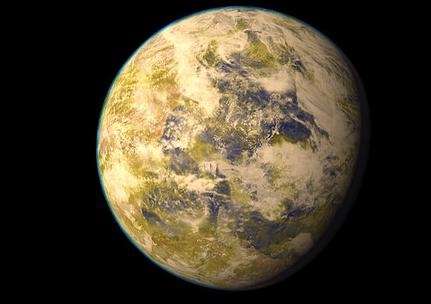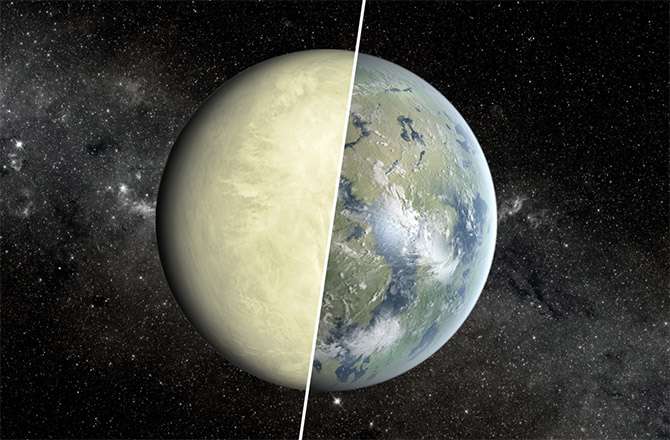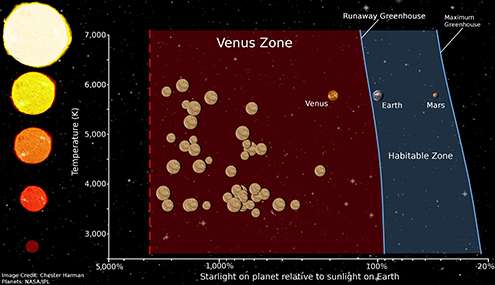Featured
- Get link
- X
- Other Apps
'Venus zone' narrows search for habitable planets

In order to weed out Venus-like planets from those that would be more habitable, several scientists, including planetary scientist Stephen Kane of San Francisco State University, proposed the establishment of a "Venus zone" around stars, a region where the atmosphere could be consumed by a runaway greenhouse effect that superheats its planets.
"We're specifically trying to make it clear that size is no indication of habitability," Kane told Astrobiology Magazine.
In other words, just because a planet is roughly the size of Earth, instead of, say, Jupiter, doesn't guarantee the conditions are right for life to evolve.
Defining the Venus Zone
The region around a star where liquid water can form on a planet is known as the habitable zone. But just because water can form doesn't mean that it does. Finding out the conditions on a planet often requires follow-up observations to the discoveries that first pinpointed it, but limitations on observation time and equipment mean prioritizing which planets should be the first to be studied in-depth.
"The primary purpose of the habitable zone is target selection," said Kane.
Kane serves as the chair of NASA's Kepler Telescope's Habitable Zone working group, which seeks to utilize all available data from NASA's Kepler mission, along with any follow-up observations, to provide the most robust list of habitable zone planets discovered by the telescope. The aim is to better understand how common Earth-sized planets are in the habitable zones of other stars. To date, the telescope has identified more than 4,100 planetary candidates.
The Venus zone would similarly serve as a target selection tool. Scientists hoping to find the next Earth-like planet perform follow-up searches on planetary candidates in the habitable zone; the establishment of a Venus zone would narrow down the inner edge of potential habitability.

A planet within the Venus zone may form an ocean at some point in its history. Like Earth, Venus was thought to contain water on its surface until approximately one billion years ago, at which point it lost its liquid.
Kane and his team labeled the point at which a planet would lose its oceans due to energy from its star as the outer edge of the Venus zone, and the inner boundary of the habitable zone. Losing liquid water would inhibit the carbon cycle of a planet, allowing more to build up in the atmosphere. Rising carbon levels would kick off a runaway greenhouse effect that would heat the planet.
The runaway greenhouse effect for a planet can be avoided if it experiences significant atmospheric loss. As the atmosphere escapes into space, it prevents the carbon from building up and superheating the planet. This loss of atmosphere establishes the inner edge of the Venus zone.
Kane presented his research at the January meeting of the American Astronomical Society in Seattle, Washington. The work was also published in the scientific journal, Astrophysical Journal Letters.
Finding Exo-Venus
The majority of the new planetary candidates discovered in recent years has come from NASA's Kepler telescope. Studying planetary atmospheres, however, continues to be a challenge, one that requires advanced telescopes and the right kind of stars, a situation that may change in the future.
"At the moment, we lack enough planets around bright stars, and we lack the resources," Kane said. "Resources means James Webb."
Set to launch in 2018, the James Webb Space Telescope will be able to search for and study planets around distant stars. At the same time, the Transiting Exoplanet Survey Satellite, or TESS, will map exoplanets around the brightest stars in the sky after its 2017 launch.

"James Webb combined with TESS will really change the game," Kane said.
Because TESS searches for transiting planets—planets that are observed as they cross between Earth and their star—it will be more sensitive to those that orbit closer to their sun.
"TESS will see a lot more exo-Venuses than it will exo-Earths," planetary atmospheric scientist James Kasting, of Penn State University, told Astrobiology Magazine in an email. "These are the planets to rule out in the search of the more interesting exo-Earths."
At the same time, studying more exo-Venuses will help to narrow down the line between the Venus zone and the habitable zone, helping scientists to pinpoint which Earth-size planets are Earth-twins, and which bear a stronger resemblance to Venus.
"Once we can observe these exo-Venuses and exo-Earths, we'll be able to determine more accurately the boundary between them," Kasting said. "Right now, that boundary is based entirely on theoretical climate models, which may not be very accurate under these distinctly non-Earth-like conditions."
Until then, scientists may have to deal with Venus-twins posing as Earth-analogues in the samples obtained by Kepler. Kane and his team identified 43 potential Venus analogs, and think that even more exist.
"I suspect a lot of Venus contamination in our sample," Kane said.
- Get link
- X
- Other Apps
Comments
Post a Comment